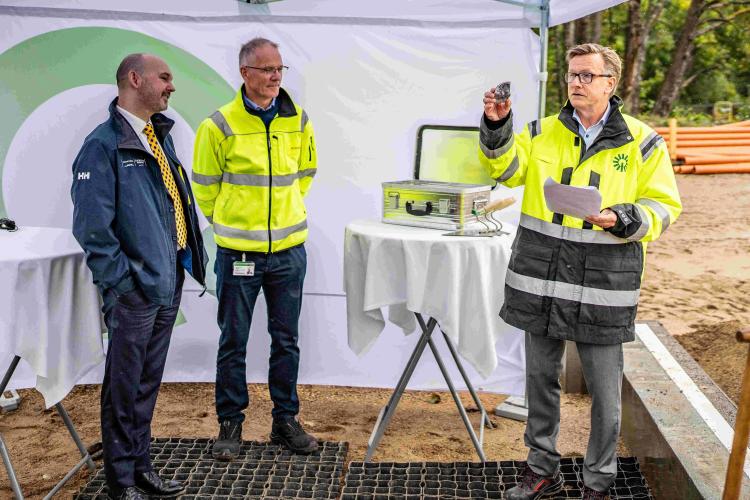There was joy at the construction site in Skejby on Friday (Sept 30), where Aarhus Municipality, Kredsløb and Innargi celebrated the start of the second phase of geothermal development in Aarhus. The construction of the heating plant that will harvest the heat from the geothermal water and send the heat home to our radiators via the district heating network is now underway.
The councillor, CEO of Kredsløb and Project Director of Innargi kneeled to lay the foundation stone for Aarhus' first geothermal heating plant in Skejby. The plant will transfer heat from the geothermal reservoir to the district heating network.
The foundation stone - which is not a stone but a metal box - contains today's newspaper, drawings of the plant, a drill core and a bottle of geothermal water. The whole ceremony is a traditional custom meant to bring good luck to the construction.
"It is very important that we prepare for the future and look for new energy sources. The geothermal plant, when completed, will have a major impact on the city. I am pleased that we in Aarhus can and dare test new ambitious solutions in close collaboration with private partners, and I have no doubt that the collaboration on geothermal energy will make other cities and companies look to Aarhus."
Nicolaj Bang
Councillor for the Department for Technology and Environment, Aarhus
"We are in the process of a comprehensive transformation of district heating. It must be composed of multiple sources and be green, so we can ensure both a robust supply and a stable price development in the future. Geothermal energy plays a key role here because the energy source does not fluctuate like solar and wind."
Bjarne Munk Jensen
CEO at Kredsløb
Earlier this year, Innargi completed the drilling of two 2.5 km deep wells in Skejby. The wells pump 70-degree geothermal water up to the surface. Here, the heat will be transferred to a heating system. This is done using heat exchangers and heat pumps. Once the heat is harvested, the cooled geothermal water is pumped back underground for reheating.
"Aarhus is a role model - we feel this when we are in dialogue with other cities in Europe. They see how geothermal energy can replace coal, gas and biomass as a stable source of heat in our radiators. Aarhus is therefore helping to show how we can solve one of the major climate problems."
Lars Bjørn Heineke
Project Director at Innargi
When all wells and plants are completed in 2030, Aarhus will have the largest geothermal district heating plant in the EU, which can cover 20% of the heat demand in Aarhus.

Image: Lars Bjørn Heineke (far right), Project Director at Innargi, presenting the contents of the time capsule, with Councillor Nicolaj Bang (far left) and CEO Bjarne Munk Jensen, Kredsløb.








